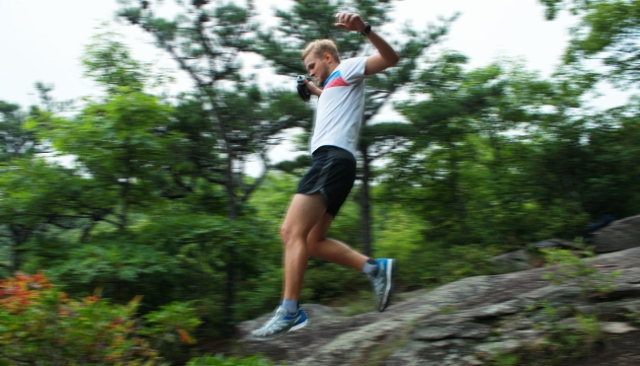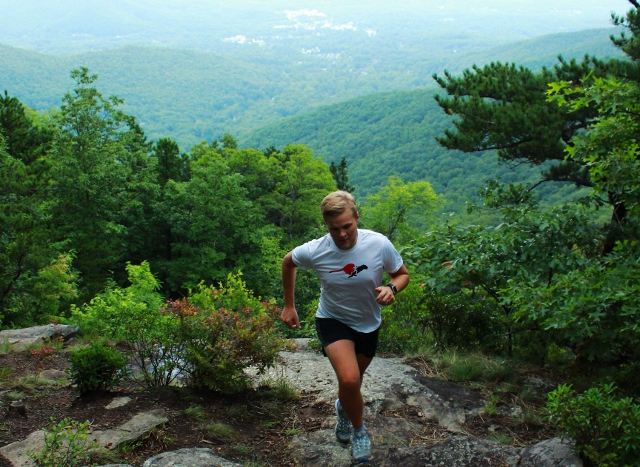Doug Hay is a 5-time ultramarathon finisher and the creator of the trail running blog, Rock Creek Runner. Just recently he finished the Massanutten Mountain Trails 100 Mile Run.

He is also the co-host of the No Meat Athlete Radio podcast, author of Discover Your Ultramarathon, and his work has been featured in Competitor, Outside Magazine, and Washingtonian among many others.
When it comes to ultras, Doug is my go-to guy (I’ve previously interviewed him about ultra running too). So today I’m excited to share his advice on how us “normal” runners can become ultra runners.
Take it away Doug!
***
I remember the first time I heard about an ultramarathon.
I was suffering through my first marathon training, when someone I knew mentioned that he was training for the JFK 50 miler outside Washington, D.C.. I listened to him tell me about the training and how excited he was for race day, and I humored him with a few questions.
A few minutes later, I left the conversation thinking, “Yeah…okay. Like that’s possible…”
I was a huge skeptic. Is running 50 miles at one time even possible? Isn’t the marathon the ultimate test of a runner’s endurance? Even if they can, why would anyone want to put themselves through something like that?
I quickly forgot about the whole thing and moved on with marathon training, thinking I was the toughest dude to have ever lived.
That was, of course, until I heard about another ultramarathon and started noticing them pop up in more articles and best selling books like Born to Run. All of a sudden, ultras were everywhere, and I couldn’t shake the thought of running one myself.
An opportunity to push my limits even further. A race that would break me down completely. Embracing the complete unknown of if my body could handle that distance and if I could stay injury free.
I wasn’t sure if it was possible, but I was determined to find out.
The problem was, I had no idea where to start:
- By how much do I need to increase my weekly mileage and long run? I wasn’t sure.
- How do I keep up with nutrition and hydration during these extra long outings? I had no idea.
- Can I run an ultra and still have a life? My guess was no.
But the more I looked into ultramarathon training, the more I realized that it isn’t much different than marathon training. If I did it right, training for a 50k or 50 mile ultra wasn’t going to take over my life or ruin all my friendships (any more than marathon training already had…).
That being said, there are a few key differences that all marathoners need to know before taking the leap to an ultra. Differences I learned the hard way. Fortunately, you don’t have to.
5 Key Steps For Transitioning from Marathoner to Ultramarathoner
Like I said earlier, running an ultramarathon isn’t as big of a shift as you might think.
Is it going to hurt? Yes. Will you want to quit? Probably.
But isn’t that true for any distance race?
1) Leave Your Fears Behind
The first step to transitioning from marathoner to ultramarathoner is checking your fears at the door and convincing yourself that you have the mental toughness to do it.
When I set out to run my first 50 miler, I had no idea what was going to happen, but I wasn’t going to let my fears keep me from finding out. Same with my first 100 miler earlier this year, where it wasn’t until the aid station at mile 89 that I could finally relax and confidently run towards the finish line.
The mental challenges, throughout both the training and the race, will be just as challenging as the physical, which is why it’s important to strip away the doubt and fear from the very start.
2) Start Running Long…And Slow
Some of my speedier marathoning friends like to joke that ultras make you slower.
That simply isn’t true.
But what is true is that most ultramarathon training consists of a significant increase in long, slow running, and very little speed work.
As you transition from the marathon mindset to that of the ultramarathon, you’ll focus heavily on the long run, building a higher mileage base, and easy mid-week mini-long runs, as I like to call them.
Success in an ultra is more about maintaining a consistent effort than it is about speed. That means slowing down to an effort that is comfortable and maintainable for 5, 7, and even 24+ hours.
It means hiking (yes, hiking! gasp!) steep hills, backing off when you feel like revving up on a flat, and slowing down a decline with ease.
The more you practice running at an easy, consistent effort, and the stronger your base, the more success you’ll have on race day.
3) Practice Course Specific Training

I have this theory that ultramarathon race directors are actually evil torturers, who get joy out of watching others suffer.
You’ve probably heard of the famously tough races like the Badwater 135 (run in Death Valley) or the Hardrock 100, with nearly 34,000 ft of elevation gain. While these might be the most extreme of the extreme, there’s one thing you can count on with most ultramarathon courses: they’re not going to be easy.
Which makes it more important than ever to train for the course, just as much as the distance.
Here are a few things to consider when practicing course specific training:
- Trails: Unlike marathons, most ultramarathons are run on trails instead of roads. Trails vary significantly, so find out how technical – or rocky, rooty, tough – the trails at your race are before race day. Get comfortable on that type of terrain so that you aren’t concerned with tripping or twisting an ankle during the race. For many ultrarunners, trails are part of the appeal, but for those transitioning from the road, learning to run trails confidently takes extra work.
- Hills: In part because they are often run on trails, ultras tend to have a lot more elevation change than a typical road marathon. The extent of those hills varies significantly between races, even sometimes between races run in the same region. Check out the elevation chart or read course descriptions, and train for the hills accordingly.
- Elevation: Many of the famous ultramarathons are run out west at elevation. But with the recent growth in popularity, ultramarathons can now be found all over. Consider the elevation of your chosen race and how that will affect you before registering.
- Heat/Cold: Nearly every marathon and shorter distance race is run first thing in the morning, when the day’s heat hasn’t yet arrived. While the gun typically goes off before dawn, they usually last well through the afternoon and beyond. Consider the time of year and location of your race, and prepare for the temperature changes that will take place throughout the hours (and hours) of running.
Now, it’s important to note that ultramarathon courses follow no set formula.
While many require trail running on hilly or mountainous terrain, that’s not true for all ultras. I’ve seen ultras run entirely on the road, the beach, and even an indoor track. Timed events, where runners run a set loop (usually 1-3 miles in length) as many times as they can for a set time, are also growing in popularity.
4) Learn How to Properly Handle Race Day Nutrition
Aside from leg strength, how you handle nutrition and hydration during the race is the next most important indicator to your ultramarathon success.
Unlike marathon nutrition consisting of limited gels and sports drinks, ultramarathon fueling is very different. Runners should plan to be out on the course several hours longer than their marathon PR, so that energy gel and sports drink alone aren’t going to be enough.
I’ve seen runners scarf down pizza, bacon and eggs, Popsicles, whole sandwiches, Coke, and any number of snacks to keep up their calorie intake and satisfy their stomachs.
A big part of your training should be learning what your body needs after hours on the trail, and how your stomach handles different foods.
I recommend that ultrarunners consume anywhere from 200-400 calories per hour throughout the race. Those calories can come from solid foods, energy gels, or high calorie energy drinks, but they need to come from somewhere, and you need to start consuming them right from the starting line.
5) Don’t Go At It Alone
When I trained for my first ultramarathon, I went at it all by myself. Aside from a few articles I found online, I didn’t think I needed the help of others.
About 4 hours into that first 50k, I realized what a massive mistake that was.
In fact, I wrote a whole ultramarathon training system to help people avoid those silly rookie mistakes I made.
Don’t go at it alone. Take advantage of what’s out there to help you make the transition:
- Read blogs like irunfar.com or my site rockcreekrunner.com
- Listen to several ultrarunning podcasts
- Connect with experienced runners at trail and ultra running clubs
- Take advantage of beginner guides like Discover Your Ultramarathon
Welcome to the Community
Ask any ultrarunner what their favorite part about ultrarunning is, and I bet that 9 out of 10 say it’s the community.
The trail and ultrarunning community is as welcoming as it gets, and we’re always eager to help out and encourage a beginner.
If you can run a marathon, you can run an ultramarathon.
So what are you waiting for? Let me be the first to welcome you to this life-changing community!
Doug Hay enjoys running through his home mountains in Western North Carolina, a strong cup of coffee, and trying to convince Jason he should sign up for a 50k. Pick up a free copy of his eBook Why Every Runner Should Be Trail Runners: And How to Become One.